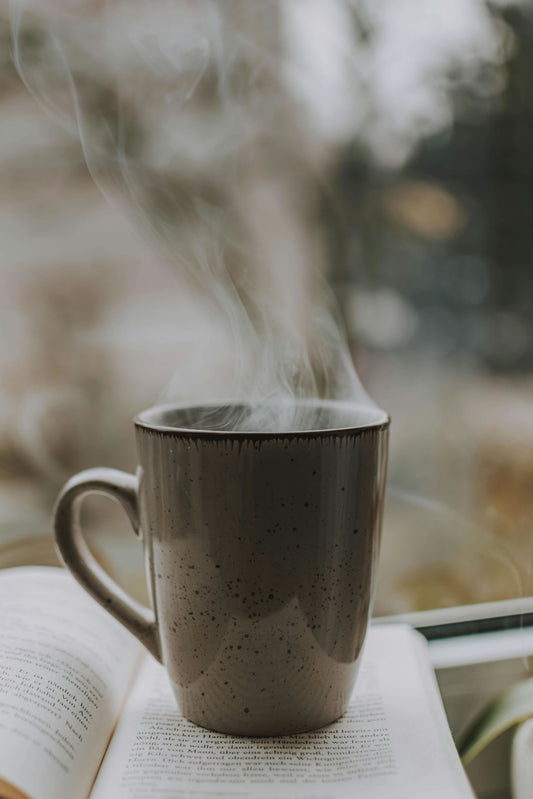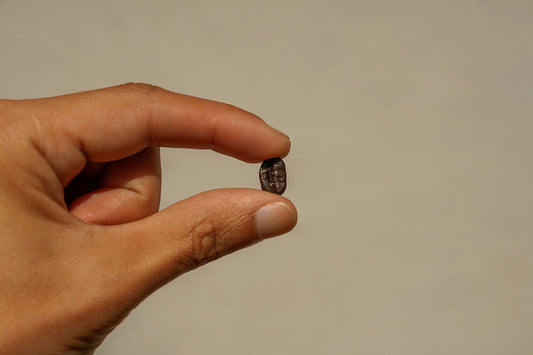Homemade matcha lattes are delicious and simple to prepare. Making your own matcha latte at home is a great way to save money and give yourself more control over the sweetness. First, sift the matcha to remove any lumps, and then whisk it thoroughly. The use of a bamboo whisk is traditional, but any metal whisk will do the trick. Use a milk frother to incorporate the milk and achieve a foamy texture.
Matcha, a powdered form of green tea, comes in two primary quality levels. Ceremonial is the finest grade and is made from the first harvest of the year. Young leaves have the most chlorophyll and are therefore the brightest in color. Sweeter flavor and a finer texture can be achieved by removing the stems and veins before grinding. The matcha used in ceremonies is meant to be consumed solely in that form.
Culinary grade matcha, on the other hand, is harvested later in the year. The increased exposure to sunlight has made the flavor of these leaves more astringent. In addition to having a more earthy and bitter flavor than ceremonial matcha leaves, they are ground more quickly. This quality is usually mixed with something else to improve the harmony of flavors.
One of the many varieties of matcha powder used in culinary preparations is latte or premium matcha, which is considered to be of exceptional quality. It has a slightly grassier flavor and less bitterness than culinary grade, making it ideal for latte art. Ceremonial grade is perfectly acceptable here. You can use any kind of milk you like, dairy or plant-based, but frothing ability varies.
What is a Matcha Latte?
How does it get made? First, a paste is made by combining a few teaspoons of matcha with water. Then, the barista can add steamed milk and decorate the latte with latte art, just like they would with a regular latte. Everything else is the same, except that the espresso is swapped out for a highly concentrated matcha "paste."
Rob Good is the proud proprietor of the Hampshire, UK coffee shop Kudos Coffee. He describes the process he and his staff go through to make the drink. "We put a spoonful of matcha in a jug with either water, milk, or a milk alternative and mix it using the steam wand," Rob explains.
We discovered that even after whisking, a few teeny lumps remained in the beverage. However, steaming results in a sleek, polished product. When we switched to this approach, customers responded positively.
Want to make a matcha latte at your house? Make sure your matcha is safe to drink before you do anything else. A good matcha will tell you where it came from or who made it. Keep it in a tin to keep it fresh (matcha only lasts about six months) and out of direct sunlight and air. Matcha is considered "stale" if the leaves have turned brown. It's safe to drink, but the taste won't be as good as usual.
What you need for a single serving is:
- 15g of filtered water, boiled to around 90°C
- 5g matcha powder
- 250g milk (or non-dairy alternative)
- Sweetener, such as honey or maple syrup (optional)
- A whisk
In a large jug, combine the matcha, the boiling water, and the sweetener (if using). Steam the milk (or your milk substitute of choice; be sure to check the temperature) and whip it with a whisk to create foam. You can skip the latte art and just pour the milk straight into the mug.
The matcha latte can be made into a "Frappuccino" by adding cold milk, serving it over ice, or topping it with sweetened whipped cream.
The "military latte" is a popular offshoot of the original drink that was popularized by Hiroshi Sawada, the first Asian to win the Latte Art World Championship. Matcha powder is the secret ingredient in the military latte, which also features espresso, cocoa powder, and vanilla syrup.
Origins of Matcha: A Brief History
By creating a state of calm alertness, Esai discovered that drinking matcha enhanced his Zen meditation sessions. (Today we know this is thanks to the interaction of matcha's caffeine and L-theanine). The refined art of the Japanese Tea Ceremony, also known as chado, was founded on matcha as its popularity grew.
Zen monks found that drinking matcha not only aided their meditation but also became a means to enlightenment. It was common practice in Buddhist temples to offer Buddha a bowl of the beverage as a sacrifice.
The tea ceremony evolved into a more subdued form in the 16th century, and the message of beauty contained in its simplicity continues to evoke admiration even in the West. It was an attempt to mimic the opulent taste of the Japanese aristocracy, which favoured Chinese designs.
Murata Shuko, a monk who advocated for radical simplicity, had an epiphany when he realised that the eternal law of the Buddha is revealed by the simple act of pouring hot water into a bowl. The harmony that develops between the hosts' and their guests' thoughts is what makes the tea ceremony so beautiful.
Peace, purity, respect, and that aforementioned harmony all capture the essence of the tea. A stress-free, beautifully executed ceremony highlights the harmony between the natural world and human endeavors.
The thin walls, flat roof, and empty walls of a tea pavilion are merely a backdrop for the ritual of preparing and sharing the drink between the host and the guests. The focus on subtle, sensual experience is a tribute to the fleeting beauty of material objects and the care with which they are handled.
Through the ages, "chado" has spread throughout Japan, reaching not only the nobility and the samurai but also the common people. As a result of the tradition's longevity, numerous schools of Japanese tea ceremony have developed and persist to this day.
The modern matcha tea ceremony is an expression of care for tradition and an opportunity for meeting and intellectual exchange.
People who can't appreciate the magnitude of small things in others often fail to recognize the significance of large ones in themselves. Okakura Kakuzo, an early twentieth-century Japanese proponent of traditional art, craft, and artistic techniques, wrote about this in a collection of essays titled "The Book of Tea."
Health and Beauty Benefits of Drinking Matcha Latte
Have you ever pondered the secret to the beautiful youth of the skin of Japanese people? Diet is a major factor. They make sure the foods they eat, which centre on raw vegetables and fish, rice, and green tea, help them look younger and have healthier skin.
Here are five ways that drinking Matcha green tea can improve your skin's health and appearance.
Antioxidant Rich = Protects Against Free Radicals & Cell Damage
In terms of nutritional value, matcha is second to none. It has more antioxidants than other so-called superfoods like blueberries, spinach, goji berries, etc.
Incorporating more of these antioxidants into your diet can:
- prevent free radicals from harming cells and DNA.
- aid in warding off cell damage brought on by noxious chemicals.
Vitamin Rich = Collagen Boosting
Matcha is packed with Vitamin B2 and Vitamin E, both incredibly essential for maintaining healthy skin and helps reduce the effects of ageing. Vitamin B2 also plays an essential role in boosting collagen. This is why you often see the use of green tea in skin care products. Collagen helps improve skin texture, elasticity and firmness.
Hormone Balancing = Less Acne/Spots
Stress and elevated levels of androgen hormones, which stimulate sebaceous glands to produce more sebum, are common contributors to hormonal acne. Matcha is a natural stress reliever and mood booster.
L-theanine, a calming amino acid found in Matcha, also aids in hormone balance by reducing cortisol levels in the body. Increased cortisol levels cause your oil glands to overproduce sebum, which can block pores and cause acne. Back to the matcha for help!
Anti-Inflammatory = Reduces Redness
Matcha's high concentration of antioxidants makes it useful for treating inflammation. Reduces inflammation, swelling, and breakouts. Drinking Matcha may be helpful for those with skin conditions like acne, eczema, and rashes.
Detoxifying = Clear Smooth Complexion
If free radicals are produced in excess, they can damage healthy cells in addition to the harmful ones. Matcha's high concentration of the catechin EGCG (Epigallocatechin gallate) helps to prevent skin damage by eliminating harmful free radicals and oxidative stress.
The benefits to your skin are just one more reason to add a cup of Matcha to your daily routine.
Why use Matcha rather than store-bought green tea? When compared to regular green tea, matcha has significantly higher levels of antioxidants, nutrients, and amino acids.
If you'd rather have a latte made with our Organic Matcha, we recommend using a plant-based milk rather than dairy because the casein protein in dairy can inhibit nutrient absorption.
Ingredients Needed for the Perfect Matcha Latte
This matcha latte only requires three simple ingredients, but it's packed with antioxidants and flavour. On chilly days, warm up with this nourishing beverage. Vegan!
- Recipe type: Beverage
- Serves: 1
Ingredients
- ½ - 1 teaspoon matcha
- ¼ cup hot water
- ¼ cup warmed coconut milk
- Maple syrup, honey, stevia, or sweetener of choice, optional
Use low-fat coconut milk, but if you want a creamier latte, go for the full-fat stuff instead.
Essential Tools for Crafting Your Latte
Making latte art at home calls for a few essential tools, including:
- Espresso Machine with a Steam Wand: This is necessary in order to bring the milk to a boil and froth it.
- Milk Jug: Latte art requires a precise pour, which can be achieved with a stainless steel milk pitcher featuring a pointed spout.
- Good Quality Coffee: There can be no artistic interaction between the milk and espresso without a solid espresso foundation.
- Fresh Milk: For the best froth for latte art, use fresh, cold milk.
Step-by-Step: How To Make Matcha Latte
Green tea leaves are ground into a fine powder to create matcha. Instead of steeping whole tea leaves in hot water, the leaves here are ground up and dissolved in the water.
If you ever find yourself in Kyoto, Japan, stop by a tea shop and pick up some matcha green tea powder to take with you. These packets can be used as presents.
This Matcha Iced Latte recipe is as easy as they come. Therefore, it's ideal for preparing at home.
Step 1
To make a cup of matcha, you'll need a measuring cup, a few tablespoons of hot water, and a few teaspoons of matcha powder.
Step 2
After the matcha has dissolved, add the remaining water and continue whisking. After about 15 minutes, I put it in the fridge or freezer to set.
The cooling process is annoying, but trust me, it's worth it for the end result.
Step 3
As soon as the matcha has cooled, fill a glass with an absurd amount of ice and pour it in. Then, add a splash of simple syrup and the almond milk (or other milk) to the glass. The final step is to add the matcha. This has led to an explosion of joy!
Cold Matcha Latte Vs. Hot Matcha Latte: What's Your Preference?
As outlined earlier, there is no best way to drink a matcha latte. You can drink it hot or cold/iced. Both of them have immense health benefits and taste nice. It all depends on how you want it. A cup of iced/cold matcha latte will leave you with a refreshing taste and strong umami flavor. In contrast, a hot brewed cup of matcha latte has a smoother texture and more intense grassy taste.
Common Mistakes to Sidestep When Preparing Matcha Latte
Matcha tea has quickly become a worldwide phenomenon. It tastes great, helps your mood, and is full of antioxidants.
However, the secret to savoring this drink is in the prep work.
Here are five common mistakes people make when making Matcha. If you want to say goodbye to unpleasant and bitter Matcha, make sure you avoid these common mistakes.
Using Boiling Hot Water
Perhaps the most typical and simple error to make when making Matcha.
You may enjoy your tea at a high temperature, but boiling water will scorch the Matcha, making it taste bitter. The optimal range for water temperature is between 70 and 80 degrees Celsius, well below the boiling point.
The simplest method involves boiling water as usual and then diluting it with some cold water to the desired temperature.
Not Using a Sieve
Matcha, being a powder, can easily become lumpy if not sieved.
You can make a smooth cup of Matcha by sifting the powder through a mesh sieve to remove any clumps.
The powder can be sifted into the whisking vessel of your choice after the appropriate amount has been added to the sieve.
Not Keeping Matcha in the Fridge after Opening
Matcha should be stored in the refrigerator in an airtight container once opened.
By doing so, the Matcha's nutrients and flavor will be preserved for a longer period of time, as it will be protected from heat, moisture, and oxygen.
Each cup of Matcha should taste as good as the last if you pay attention to how you store it.
Leaving Matcha Exposed to Sunlight
The aroma-producing oils in tea leaves are susceptible to degradation when exposed to ultraviolet light.
Given Matcha's delicate nature, this could drastically alter the beverage's flavour.
Keep your Matcha in a dark, opaque container away from light to maintain its quality.
Stirring with a Spoon instead of a Bamboo Whisk
Matcha is best prepared with a bamboo whisk, not a spoon.
Matcha needs to be whisked for about 30 seconds with a Matcha whisk before it becomes smooth and foamy.
You shouldn't use a spoon because it doesn't aerate the Matcha and it collects the powder into clumps.
Moringa's Role in Juju Blends Matcha Latte
One of the most notable aspects of Juju Blends' Matcha Latte is the novel blend of matcha and moringa. Matcha, a type of green tea known for its robust, earthy flavor and exceptionally high antioxidant content, is rapidly growing in popularity.
But moringa, also called the miracle tree, produces an abundance of nutritious food. Due to its high content of beneficial nutrients like B vitamins, minerals, and amino acids, it is a nutritional powerhouse.
The combination of these two ingredients has a synergistic effect on health. Moringa's high vitamin A, vitamin C, and iron content is an added nutritional layer, and its anti-inflammatory properties complement matcha's potential to increase metabolism and focus.
Matcha and moringa work together to stimulate the senses and nourish the body, making Juju Blends Matcha Latte a delicious wellness elixir.
3 Easy Steps To Making Barista-style Juju Matcha Latte
Step 1
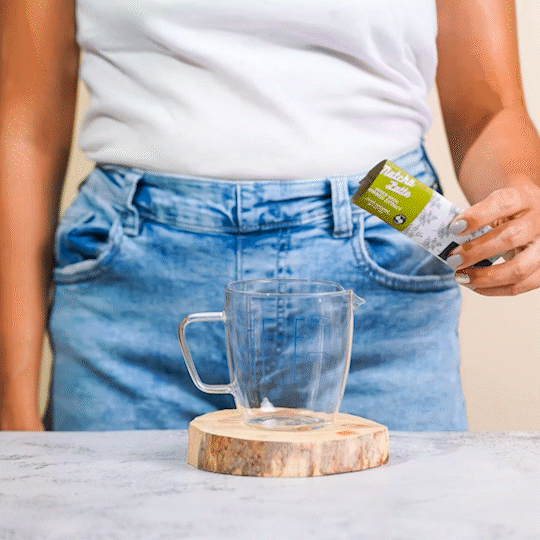
Pour the contents of one sachet into your favorite glass or mug.
Step 2
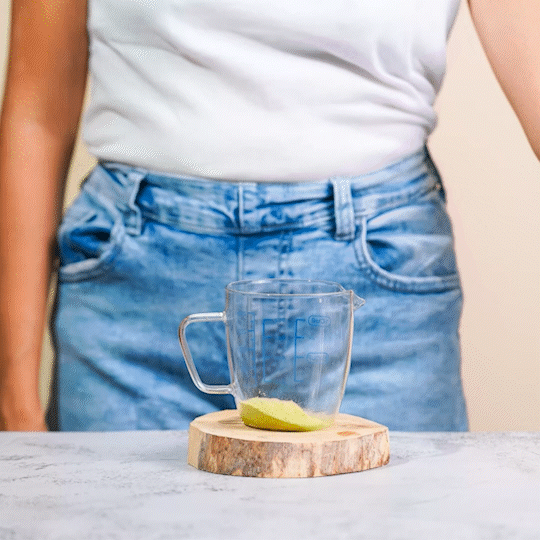
Add water.
Step 3
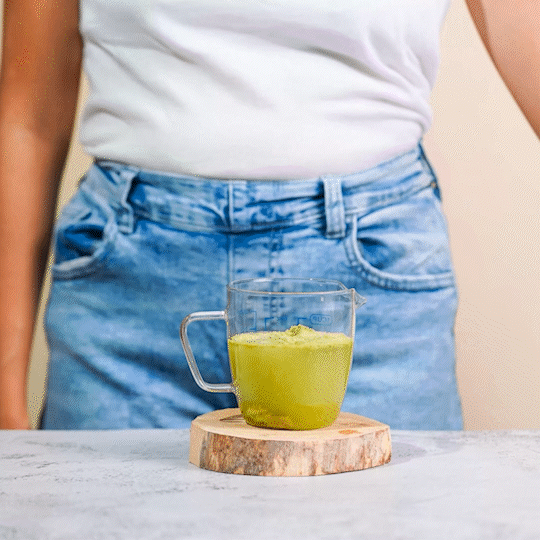
Mix & enjoy.
Importance of Choosing the Best Matcha
Choosing the highest quality matcha, particularly ceremonial-grade matcha, is paramount in unlocking the full spectrum of benefits and flavors this revered Japanese green tea has to offer. The significance of opting for a high-grade matcha lies in its meticulous cultivation, processing, and distinctive characteristics.
Ceremonial-grade matcha is the crème de la crème, known for its vibrant, emerald hue, silky texture, and unparalleled smoothness. It is shade-grown for up to 20-30 days before harvest, intensifying its chlorophyll content and boosting its amino acid, L-theanine, responsible for a calming alertness.
This grade is stone-ground to a fine, talc-like powder, ensuring an exquisitely smooth and velvety mouthfeel. Such meticulous processing results in a tea that is rich in umami, exhibiting a harmonious balance of sweet, bitter, and savory notes.
The exceptional care taken in producing ceremonial-grade matcha elevates not only its flavor but also its health benefits, packing a concentrated dose of antioxidants and providing a sustained, jitter-free energy boost. In the realm of matcha, investing in a high-grade variety is an investment in an elevated sensory experience and a heightened sense of well-being.
Frequently Asked Questions
Are matcha lattes healthy?
Matcha contains the nutrients from the entire tea leaf and contains more caffeine and
antioxidants are typically present in green tea. Studies of matcha and its components have unearthed a variety of benefits, showing that it can help protect the liver, promote heart health, and even aid in weight loss.
Do you mix matcha powder with water or milk?
Traditional matcha green tea is made with just green tea powder and water, but you can also easily make a latte by finishing your drink with steamed milk. I love to make mine with almond milk, coconut milk, or homemade oat milk. Whisk again until foamy, sweeten to taste, and enjoy!
What milk to make matcha?
Whole Milk, Low Fat or Fat Free Milk for Your Matcha Latte
Is it OK to drink matcha latte everyday?
Rest assured, any amount of matcha can and will benefit your health, though our most common recommendation is 2–3 servings per day for the average person — including healthy pregnant women.
Is matcha better with cold or hot water?
There are a few tea masters in Japan who take this even further and suggest that the optimal way to prepare matcha is with cool water, averring that only with cooler water can maximum umami be coaxed out of the tea. And it's true: matcha prepared with cooler water does bring out more umami.
Conclusion
To make a delicious matcha latte, start by sifting 1-2 teaspoons of high-quality matcha powder into a cup. Heat a small amount of hot water to about 175°F (80°C) and pour it over the matcha powder.
Use a bamboo whisk or a frothier to mix the matcha and water until it forms a smooth, vibrant green paste. In a separate container, heat your choice of milk (such as almond, soy, or regular dairy milk) until hot but not boiling.
Pour the hot milk into the cup with the matcha paste and stir well. You can sweeten your matcha latte with honey, agave syrup, or sugar to taste. Voilà! You now know how to make a delicious matcha latte at home, a perfect balance of earthy matcha and creamy milk.



